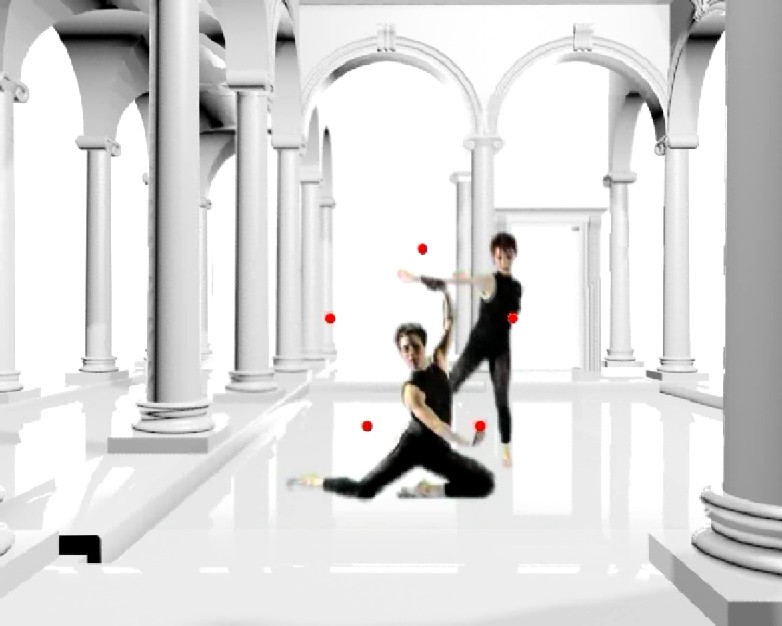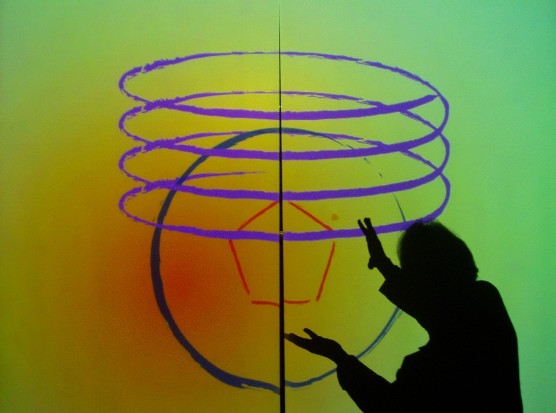 |
|
|||||
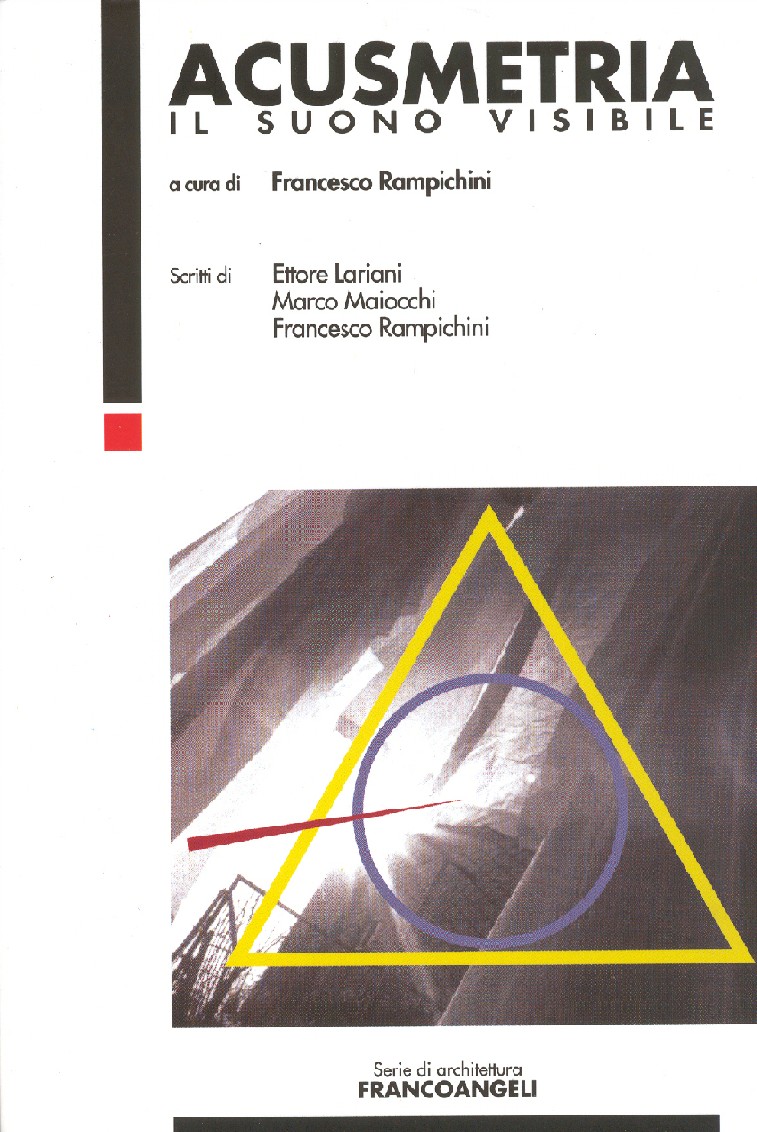 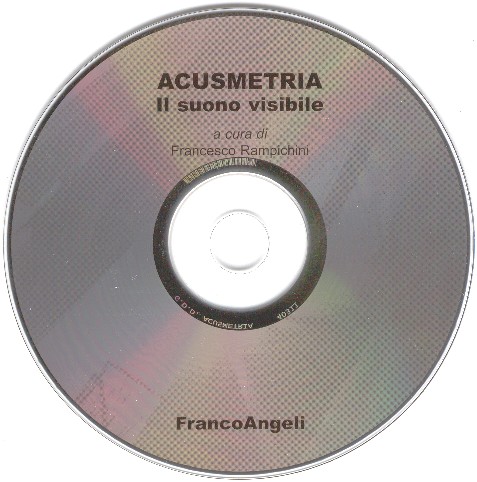 by Francesco Rampichini The research project on Acusmetria with Prof. Giacomo Rizzolatti, discoverer of mirror neurons, is taking shape. Soon on this page for updates. Acousmetry turned upside down the metaphysical castle of sensoriality. (Carlo Sini)
I
consider your research of great interest and brings me back
nostalgically to many discourses that often Luigi Nono made me. (Andrea Branzi)
Acousmetric is the natural condition of every I listening. This King has always been naked but, as usual, it was necessary that someone would notice. (Giorgio
A.
Riva)
Acousmetry n. (from
greek akouō, to hear, and metréo, to measure).
Neologism created
in 2002 by F. Rampichini. Acousmetry is the discipline of perceiving
geometric
proportions by hearing; it uses sounds properly organised to draw dots,
lines
and surfaces in a spatial perspective, and works tuning three
fundamental
parameters: sound dynamics (near/far), pitch (high/low), stereophonic
balance
(right/left). The acousmetric
space: Π (lateral movement);
A (height); I (depht).
As geometry
is the art of measuring the land (gea), and, in a
broader
sense, Acousmetry
arises from a gesture, a simple one such as
to draw with a pencil, transposed into sounds. It studies the
relationships
between the properties of heard sound models and the corresponding
geometric
shapes, analogically evoked by listening. The analogy is based on the
ratios
between parameters in sound and geometry: loudness vs distance, pitch
vs
height, stereophony vs right/left position. As the drawing gesture can
be
different in time to execution, acceleration or stroke thickness, the
same
apply to the sound parameters, f.i. in pitch rising time, in left to
right
movement speed, and so on. Those correspondences are presumably
synaesthetic
phenomena, evoked by listening, and supported by the visual perception
experience. We
experienced that after having provided few information about the “sound
sheet”
and some commented examples, acousmetric shapes (such as dot, line
triangle,
square, pentagon, circle, etc.) are easily recognised and graphically
reproduced by the listeners [1]. As
any other code, acousmetry requires a learning phase (in this case
really
short). Children learn at the school to recognise a triangle, to
distinguish
between an “A” and an “I” and to reproduce different sound as
correspondences;
we learn foreign languages through laborious mnemonic exercises; a
musician can
recognise a 7thdim chord after a heavy and long training of
the
musical code; all these examples impose a linguistic context as a
common
reference. We
are verifying the acousmetric perception through tests submitted to
statistical
analysis: the tests consist of listening sample acousmetric shapes, and
of
drawing the corresponding graphics on a paper; the data presently
available are
under process, but the high percentage of positive results already can
convince
that everybody can perceive acousmetric shapes, and that the phenomenon
is
general. Acousmetry
is a discipline rigorously formalised, according with three parameters,
we
refer to the three spatial co-ordinates: Right-left.
The diffusion
of stereophonic recordings made us used to perceive sound on a left- or
rightside; a continuous shift of the balance from left to right is felt
as a
sound dot moving in the same direction. Front-back. The
perception of the depth (near-far) with two loudspeakers appeals to
linguistic
metaphors and to experiential interpretations, and two mechanisms apply
for
still or moving sources. Still
sources: our experience says that weak signals
come from far sources; more we have a model describing mathematically
the
phenomenon: the intensity of the perceived signal decreases with the
square of
the distance; we can control the
loudness of a
signal following the above law, in order to represent the required
spatial
distance. Moving
sources: for low speeds, the above
considerations on still sources apply; for fast speed, the Döppler
effect can
be used, increasing the frequency of the sounds coming toward us and
decreasing
it for sources going away from us. The
mechanisms are in the hands of the acousmetric
composer: if the goal is the representation of a central far source
approaching
fast the listener, he will provide a central sound, initially weak,
becoming
louder and louder while increasing in the pitch. Possible ambiguous
representations
shown that the listener chooses the simpler to be interpreted [2]: F.i., with
two loudspeakers, if a central weak sound
grows in volume and pitch till a maximum for returning then to initial
volume
and pitch, a listener positioned in the mid point between the two
speakers
could interpret it as a sound dot coming from far and returning back or
as
coming from far and going far behind him. According
to a principle of continuity, the listener
prefers feel the second solution. The
parameters of such a sound can be physically
modelled as shown in fig.2, supposing a listener centered between the
speakers
and looking toward the front part: - at T0
the source starts to give out a
weak sound; the weakness induces the interpretation: either weak in
itself or
far; A listener
in the same position but looking in the
backward direction will feel the same phenomenon: the sound coming from
far in
front to him and moving away back. While the
perception left-right corresponds to the
real physical phenomenon (the sound comes from left or right, or the
ears
process the position according to the average of the intensities coming
from
left and right; we can measure in meters th distance between the
speakers and
express in meters the position of the sound), the perception far-near,
coming-going are ruled by “state variables”: they are meaningful only
in a
comparison (3). High-low. The use
of
two speakers only allows the perception of high and low position
through
metaphoric linguistic mechanisms. The terms “high” and “low”, “up” and
“down”,
are really powerful in the day by day communication: we go down the
stairs or
up at home (real physical interpretation), but the stock exchange is
going up
or down, we say “up with the people”, “I’m down today”, and so on. The same
metaphor is used in music, with sounds going
up (pitch) and becoming high, or goes down becoming low. A sound coming
from
the left speaker increasing continuously its pitch is interpreted as
dot
spatially rising on the left party of our sound sheet. The reverse for
dots
moving down. Acousmetry
formalises the correspondence sound –
shape; f.i. we could model the gesture of a diagonal segment from the
lower
left corner to the upper right as a couple of coordinates changing in
the time: x =
kt
y = kt and the
corresponding acousmetric shape will map x on
the speakers balance, and y on the pitch . The process is invertible
(in a
mathematic sense, and an acousmetric shape generated starting from a
geometric
one can be examined to re-generate the original gesture. 
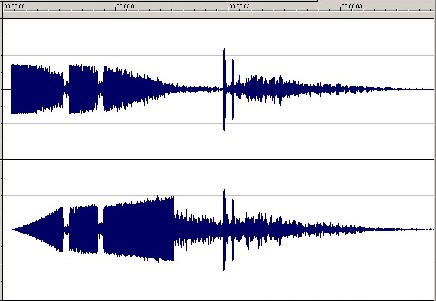 Acousmetrisation
of a
logo
[1 ]This
analogy with graphics goes further on: as for the drawings on a paper,
symbolic
three-dimensional representations are based on metaphors and codes, and
perceptive paradoxes maintain their validity. [2] Similar
behaviours can be recognised in some visual perceptions, such as the
principles
of similarity, continuity, symmetry, etc. ruling the interpretation of
figures;
see f.i. the works of Gombrich on the Gestalt.. [3] Various
experiments shown that different listener perceived the same shape, but
often
with different sizes when the loudness parameter was involved, as well
as when
the last one, of the pitch. We suppose this is related to the
linguistic
metaphorical nature of the interpretation. Radio Classica (28 January 2008) Interview to Francesco Rampichini, by R. Belgiojoso Tabloid (April 2005) La libreria di Tabloid: "Acusmetria. Il suono visibile", P. A. Paganini Tribuna stampa (January/February 2005) Libri - Acusmetria. Il suono visibile, S. Annibaldi Corriere del Mezzogiorno (22 October 2004) I Festa dell'archittettura: a Napoli tre giorni per sognare, by D. Lama Il Mattino (21 October 2004) I valori dell'architettura Suonare News (n. 98, September 2004) Capriccio spaziale, by A. Bertolini Modo (July/August 2004) ACUSMETRIA - Geometria del suono, by A. Fanelli Il Manifesto (Alias, 26 June 2004, p. 22) Che bell'edificio di mattoni sonori, by M. Sebregondi Wayfitness - (May 2004) Ascolta questa bella geometria Radio 24 (8 August 2004) Interview to Francesco Rampichini, M. Daghini  Radio 24 (11 May 2004) Interview to Marco Maiocchi, S. Coyaud  Corriere della sera ("Sette", 29 April 2004, p. 107) Studi di frontiera - l'Acusmetria, by A. Pasini Foglio dell'Institutum Pataphysicum Partenopeium n° 2 (summer 2003) - Acusmetria - a tale by Marco Maiocchi 20 march 2005 - h 16,15 Seminars of Mathematics Culture Mathematics Dep. of Milan's Polytechnic - Square Leonardo da Vinci, 32 Seminar: "Acousmetry. The visibile sound" - by: F. Rampichini (musician), M. Maiocchi (physicist), E. Lariani (architect) 18-22 november 2004 Futurshow Fair of Milan, stand I.NET, permanent projection of "U.V.A.", acousmetric dance by F. Rampichini - collaboration and co-ordination: E. Lariani, M. Maiocchi - U.V.A. for I.NET 11-12 november 2004 International Conference on Innovation by Brand and Design Management Organized by the Design Management Institute - Paper: E. Lariani, M. Maiocchi, F. Rampichini, Acousmetric Branding. Seoul, Korea Co-Sponsored by:
Design Management Institute - The 12th International Forum on Design Management Research & Education Design and Brand Management Society - The 2nd Annual Conference Institute for Industrial Policy Studies - Brand Management Institute - 3rd Annual Conference of Brand Management Institute 22-23-24 october 2004 Frame & Mutations - Festa Europea dell’Architettura, Naples (from the catalogue) 26 june 2004 International University of second renaissance Conference held by Marco Maiocchi, Francesco Rampichini, Ettore Lariani - Introduction by Armando Verdiglione - Senago, Villa San Carlo Borromeo 21 june 2004 Mathematics Department - Polyitechnic of Milan Acousmetry - Meeting organized by prof. Tullia Norando, Dept. of Mathematics "Francesco Brioschi" 12 may 2004 Triennale of Milan - Festival dell'Architettura Presentation of the Acousmetry "U.V.A." on youtube
From
"Capriccio spaziale"
a.a. 2002-2003
Polytechnic of
Milan - Department of Design
rel. Ettore Lariani -
co-rel. Francesco Rampichini
In 4 volumes:
- Progettazione acusmetrica
integrata negli spazi allestiti
by Nicola Moioli
- Progetto architettonico di recupero
dell'area industriale dismessa
by Nicola Seta
- Allestimento e
organizzazione degli spazi interni ed esterni
by Federico Vedani
by Erika Gagliardini- Progetto dell'immagine coordinata e dei sistemi di comunicazione by Martino Pannofino (acousmetry: a new code) a.a. 2003-2004 rel. Pier
Federico Caliari - co-rel. Francesco Rampichini
LA MACCHINA ACUSMETRICA TOTALE (the total acousmetric machine) a.a. 2004-2005 - Politecnico di Milano - III Facoltà del Design rel. Marco Maiocchi - co-rel. Ettore Lariani, Francesco Rampichini by Christian Sciascia ACUSMETRIA - 3° International Young Inventors Fair (IEYI) New Dehli - India, december 2006 authors: Stefano Bolzonella, Boris Nani, Fabio Turi university tutors: Marco Maiocchi, Ettore Lariani, Francesco Rampichini teacher: Maristella Galeazzi school: Liceo Scientifico "E. Fermi" - Cantù (CO) - Paper Info on some thesis >> Polytechnic of Milan - OPAC Librarian Services |
EXTERNAL LINKS:  Acousmetry Publisher's page Excerpt from google books Infrapedia IN THIS PAGE: WHAT IS ACOUSMETRY PRESENTATIONS DEGREE THESIS PRESS |


